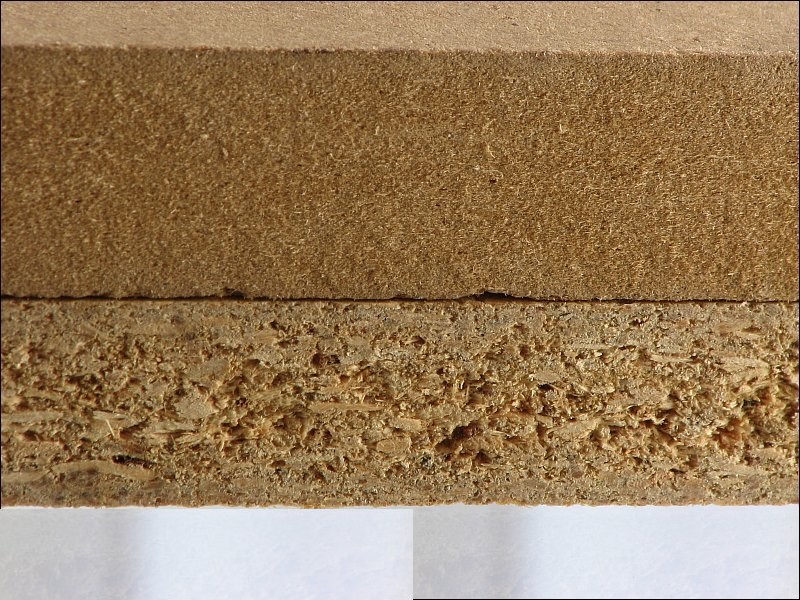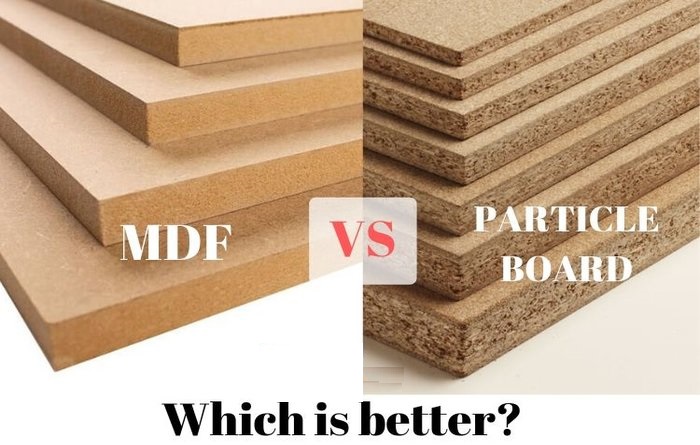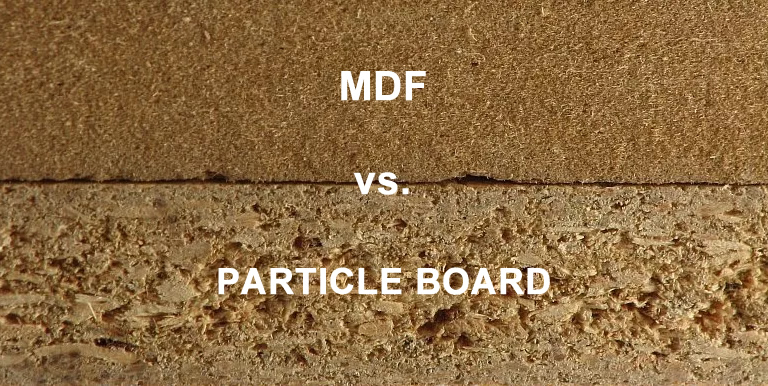There has been a rapid depletion or reduction of solid woods and challenges in obtaining large and flat panels. Due to these scenarios, people have learned to produce wood products to fulfill their needs. This is precisely where engineered woods come in. Under this wood, categories are Medium Density Fiberboard or MDF and particleboard.
Suppose you want to learn more about the difference of MDF and particleboard. In that case, this mdf vs particle board write-up will provide you with information to better understand how these products differ in terms of applications, compositions, looks, and many other aspects.
MDF vs Particle Board-Introducing Each Type

Medium Density Fiberboard or MDF is a high-grade and durable composite material made from resin and recycled wood fibers. This wood product is made by means of breaking down the soft and hard wood into wood fibers. MDF is dried and eventually pressed to create stable and dense sheets. These are then combined with the resin and wax forming panels when intense pressure and temperature are applied.
The process of making MDF sheets is quite unique. The truth is that this particular process is what paved the way for MDF to be much denser and more robust than particleboard. MDF is also thicker than plywood. This wood product has an even thickness and smoothness on both sides. This is a hardboard glued and heated and eventually comes out strong and suitable for various applications such as:
- Handicraft items made of wood
- Decorative wall cladding
- Interior paneling and cladding
- Kitchen cabinets
- Divider doors
- Cupboards
- Shelving
- Shutter and panel boards
On the other hand, particleboard is another type of engineered wood product also called chipboard or low-density fiberboard. This wood-based construction material is made by compressing or heat pressing saw dust and wood chips with the aid of glue and squeezing them together to create sheets.
Wood chips found on the surface layer tend to be thinner than the chips on the middle portion. Thus, particle boards are more compact and denser at the center. The quantity of glue used in particle boards is about 10%. This material is often veneered, coated, and used in buildings, furniture, and more where stronger materials aren’t required. Particleboard is suitable for various applications such as:
- Insulation
- Cabinets
- Flooring beneath tiles or carpet
- Furniture
The Differences Between MDF and Particleboard

As more people are becoming curious and interested in good alternative wood products, the number of individuals who are searching for information, particularly mdf vs particle board, also increases. Knowing the differences between the two can help you decide which one is best suited for your woodwork or projects.
Mdf vs particle board-Characteristics and Physical Properties
MDF has become a common name for dry-process fiberboard. This is commonly composed of 82% wood fiber and about 9% resin glue, 1% paraffin wax, and 8% water. When examined in connection with the density of the fiber, the board’s density which goes to creating the panel is imperative. The density falls between 500 and 1000 kg/m3.
Thick MDF panels at 700 to 720 kg/m3 density might be considered as high density on softwood fiber panels. The panel with similar density made of hardwood fibers isn’t regarded as such. The evolution of several types of MDF was triggered by the varying needs for specific purposes and applications.
On the other hand, particleboard is more uniform and denser than plywood and conventional wood. Though this is denser than traditional wood, this is the weakest and lightest fiberboard. It is often the alternative when cost tends to be more essential than appearance and strength. Particleboard becomes more appealing through painting or using wood veneers on visible surfaces. Different grades of this board mean different densities.
One of the disadvantages of particleboard is its vulnerability to discoloration due to moisture absorption and suspension, specifically when it isn’t covered with sealer or paint. Thus, this is seldom used outdoors or in areas with high moisture except in laundries, kitchens, and bathrooms. In dry settings or environments, veneered particle boards are preferred more than veneer plywood due to their convenience, lower cost, and stability.
Mdf vs particle board-Composition
The process of manufacturing MDF is the same with particle board-thermally bounded and pressed wood fibers. The significant difference is the size of fibers used. These are smaller, resulting in stronger, denser, and more uniform material.
On the other hand, particleboard comprises wood chips that are chopped finely and mixed with synthetic resins and glue, hot pressed. This wood product is also referred to as chipboard, composed of thin layers of veneer thermally pressed and glued together.
Mdf vs particle board-Strength
MDF is noted for its higher strength and hardness as compared to solid wood. The particleboard has lower strength and hardness because of its lower density.
Mdf vs particle board-Patterns
MDF is available in a wide array of structures, patterns, and shades that mimic marble, wood, and natural stone. The particleboard is available in several imitations and a rich color palette.
Mdf vs particle board-Strength and Durability
MDF is known to be fairly stronger than the particleboard, while the latter isn’t very strong. MDF is more sturdy when it comes to durability, while particleboard is less durable.
Mdf vs particle board-Lifespan
If taken care of and maintained properly, MDF can remain in top condition for up to 10 years, while particleboards can last for 25 years.
Mdf vs particle board-Cost
MDF is costlier than particleboard. Since particleboard is very heavy, dense, and isn’t suited for large cabinets, this costs less than MDF.
Conclusion
If you’re seeking for the best yet most affordable wood composite for your home or office furniture, you might be looking at this Mdf vs particle board to learn the differences between each type. Here, we have explained to you the differences between MDF and particleboard in terms of characteristics, physical properties, composition, strength, patterns, durability, lifespan, and cost. Ensure that you understand these differences to make choosing and buying decisions easy.

Leave a Reply